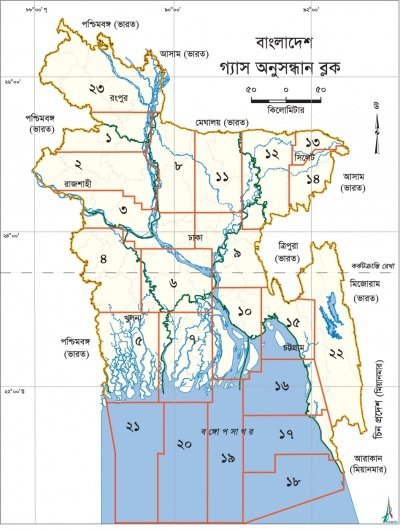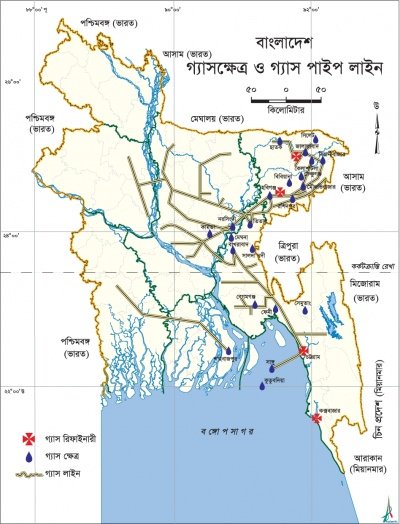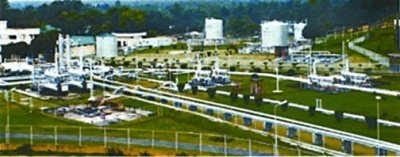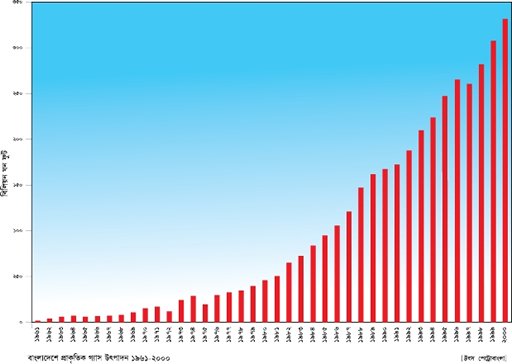Natural gas
Natural gas is a mix of combustible gas (often associated with mineral oil) that is obtained from the crust. Apart from coal and oil, one of the three fossil fuels in the world. In other words, the natural pressure and hydrocarbon gas in the gas or vapor is natural gas. Although its main components are methane, ethane, propane and other components may also be present in it. Common offenses include nitrogen, carbon dioxide and hydrogen sulfide. Natural gas may also be self-sufficient and may also be available with oil.
Bangladesh is always considered as a natural gas rich country, because it is a delta region with porous and permeable hydrocarbons with siltation to create sandy soil and unique trap. This gas balloon extends from greater Sylhet to the greater eastern region of the country to greater Comilla, Noakhali and Chittagong areas. Natural gas has been discovered on the coast of the Bay of Bengal.
Natural gas plays an important role in our economy. The eco-friendly fuel, on the other hand, has a pure flame, as well as its cremation process is stubborn. The use of household cooking, in the factories (in the case of chromosomics, pottery, glass, bread biscuits, power stations, cement, steam boilers etc.) and in agriculture (dry and sanitation and steam boilers fuel) is widespread. Natural gas provides liquefied petroleum gas, liquefied natural gas and shrinking natural gas and can be used as fuel for domestic, industrial and agricultural purposes. In the chemical industry, natural gas is used in chemicals such as synthetic fertilizers, plastic, resin, rubber, carbon black, detergents, ammonia and nitric acid.
Search History In the second half of the nineteenth century, Assam Railway and Trading Company built the first railway in the eastern part of the subcontinent. The company started the first hydrocarbon in 1883 and started drilling in this area. Later, the Assam Oil Company, established for sale and sale of petroleum in the local market, started the petroleum exploration activities in 1911 as the successor of the previous company. Surma Basin and Chittagong areas were included in Burma Oil Company's search program.
During 1908 to 1914, the Indo-Burma Petroleum Company excavated a few detecting wells in Sitakunda. In Bangladesh, 6 wells have been excavated since 1914. Local and foreign companies have excavated a considerable number of wells in the region for gas exploration. As a result of the search activity in the country, one oil and 23 gas fields have been discovered. Initially (1910-1933) oil and gas exploration wells were originally installed in the springs or emission areas of the fold region. At this time, the exploration wells from 763 meters to 1050 meters depth were excavated. With the availability of better technology, it has been possible to ensure digging deep well and increase the success rate in search. In 1955, Burma Oil Company discovered the first gas field in the country. Successful discoveries of many gas fields in the sixties and seventies have proved that by digging wells. Success in one of the three drilling operations for excavation of petroleum exploration wells is very encouraging. However, during the intervening period of 1910-1933, there were 6 drilling in the country but the discovery of a commercially important gas field was not possible. In the beginning of World War II, a new initiative of petroleum exploration was initiated and during the period 1951-1970, 22 wells were excavated, resulting in 8 gas fields being discovered. In the third phase of oil-gas exploration (1972-1992), nine new gas fields were discovered by excavating 24 wells, and during the 1993-2000 period, five more new gas fields were discovered by digging 10 wells.
In the country, in 1959, the first gas from the Chhatak gas field was introduced in the industrial area. In the year 1968, Shawkat Osman, a renowned writer, was given the first gas pipeline in the Dhanmondi residential area. The major uses of gas in the industrial sector are electricity generation. Other major gas users in the industry are: Fertilizer Factory, Cement Factory, Pump and Paper Mill. These industrial factories are mainly located in the eastern and central regions of the country. Currently, gas production is being made from about 17 wells of 17 gas fields in Bangladesh. The daily average production of gas is about 2000 million cubic feet, of which international oil companies are producing approximately 960 million cubic feet of gas. Today the daily demand of natural gas is around 2400 million cubic feet and the demand is increasing day by day. As a result of its enormous use of environmentally friendly fuel, it is widely used in households, transport systems, industries, fertilizers and power generation sectors. Since Bangladesh's energy is largely dependent on natural gas, Bangladesh will have to face tough energy crisis if the gas fields increase gas output, discover new gas fields and ensure the use of alternative fuel. The use of gas in the year 1960 was 10 million cubic feet per day.

Gas Prog (Bangladesh) is a proven gas prone country in Bangladesh. Gas was originally found in the rock of Bhuban and Bokabil formation. Myosin clay rock, especially middle and elderly Bhuban, whose language is 0.9%, gas prone, and it must be classified as marginal source rock. The Miocene Bhuban and Bokabil formation achieved only 30 million to 4 million years ago in the gas-rich maturity, especially in the deeper basin region and the old Bhuban formation. The gases produced from these sediments are almost completely enclosed by anticline which was developed at Surma Basin during that time. Some geologists believe that the clay source of the Bhuban formation is not full enough to be organic enough to be rock. They also believe that the old Oligocene Barail rock clay is full of biomass and produces gas than the Bhuban Formation. Later, after a few kilometers migration towards the upward slope of the gas rocks, finally the Bhaban and Bokabil formations are stored in the sandstone reservoir. [Sifatul Quader Chowdhury]
Total gas fields have been discovered in Bangladesh since 2010. Among the discovered gasfields, the Bay of Bengal, and the remaining gas fields are located in the eastern part of the country, near the coast. Total gas initially in place-GIIP is estimated to be 26 trillion cubic feet of the total 23 reservoirs in which the reserves are considered to be 21 trillion cubic feet. By the end of 2010, about 8 trillion cubic feet of gas was lifted and the remaining amount was approximately 12.1 trillion cubic feet. The natural gas found in the sandstone reservoir of pliocene (2 million to 5 million years ago) - Miocene (5 million to 24 million years ago), at a depth of about 1,000 to 3,500 meters of the surface of the Earth.

The natural gas found in Bangladesh is more pure, about 95% to 99% of which methane and sulfur are almost absent. The average structure of natural gas is methane 97.33 percent, Ethan 1.72 percent, proportion is 0.35 percent, and the rest 0.19 is higher hydrocarbons. Most gasfields are dry, but moist gas is present in the few gas fields with significant quantities of condensate. Wet gas fields are Beanibazar (Condensate 16 barrels / million cubic feet), Jalalabad (Condensate 15 barrels / million cubic feet gas) and Kailashtila (Condensate 11 barrels / million cubic feet). Total estimated reserves of the condensate in the country are about 65 million barrels.
One thing from the geological structure of the country is clear that in addition to the already discovered gasfields, the possibility of discovering more gas fields in the future is very bright. Natural gas plays an important role in the economic development of the country.
The gas fields discovered in the country are Sylhet, Chhatak, Titas, Rashidpur, Kailashtila, Habiganj, Bakhrabad, Semutang, Kutubdia, Begumganj, Kamta, Feni, Beanibazar, Fenchuganj, Jalalabad, Narsingdi, Meghna, Shahbazpur, Saldanadi, Sangu, Bibiyana and Moulvibazar. Most of the gas fields are located in the adjoining land of Indo-Burma in the eastern part of Bangladesh.
Generally, natural gas is stored in anticlinal traps. The gases are very good to the best, depending on the quality of the reservoir, porosity etc. Many gas fields have multiple sandstone gases, even some of which contain 12 gas-sandstone regions. The results of various types of testing of gas from the gas fields of Bangladesh indicate that in most cases natural gas from organic matter is produced and stored in the oil window. The source of the gas is usually clay in the Barail Shelladal Oligosine (from the present day to 2.4 million to 3.1 million years ago). Fault from this gas oligosine sludge foliage.The idea of geologists is that the Miocene is deposited in the sandstone reservoir by passing through the nalo from the middle of the upper medium.
Sylhet gas field located 20 km northeast of Sylhet city. Pakistan Petroleum Limited (PPL) discovered the gas field in 1955. The company excavated a total of 7 wells. In between, Sylhet-1 well was blo-out. Currently, gas is being extracted from Sylhet-3 and Sylhet-6 wells. Sylhet-7 no. Well is the only well, from where the crude oil of oil was raised 100 to 300 barrels per day till 1992.
Located in Sunamganj district of Chhatak gas field, this gas field was discovered by Pakistan Petroleum Limited in 1959. In this gas field, the well is dug up to a depth of 2,133 m. Due to excessive flow of water, the production of Chhatak gas field was stopped since 1985.

Titas gas field is one of the largest gas fields in the country and the important gas producing areas till the present time. The gas field located in Brahmanbaria district discovered the Pakistan Shell Oil Company in 1962. Up to 2000, 14 wells have been excavated. This area of 64 sq km wide is domed with dome-shaped area. Most of the granules produced in gas are 2,616 meters to 3,124 meters in depth. Total estimated reserves of the Titas gas field are about 4.13 trillion cubic feet, of which 1.3 trillion cubic feet of extractable reserves Till the end of 2000, a total of 1.72 TCF gas was withdrawn from this gas field, which is about 75 percent of the total recoverable reserves.
Rashidpur gas field located in Moulvibazar district, this gas field was discovered in 1960. Four wells have been excavated in this land formation. There is a total of 2.24 TCF of gas in which the reservoir reserves are 1.30 TCF.
Kailashtila gasfield is located in Sylhet district; One of the largest gas fields in Bangladesh. The Pakistan Shell Oil Company discovered this gas field in 1962. Total estimated reserves of 3.65 TCF, of which 2.52 TCF gas is extractable. Significant quantities of condensate are produced with gas from Kailashtila gas field. Since 1983, gas fields have been extracted.
Habiganj gas field is one of the largest gasfields in the country, discovered in 1963. It is 11 km long and 4.5 km wide. About 30 percent of the porous Habiganj gas field is known as a high quality gas reservoir. Currently it is one of the country's largest gas production fields. To date, 10 wells have been excavated in this gas field.
Bakhrabad gasfield is located in Comilla district. In 1969, Shell Oil Company discovered this gas field. From here onwards, gas production started in 1984 and reached its highest production in 1993 (190 million cubic feet daily). Since then, the pressure and production of this gas field has rapidly fallen. At the end of 2000, only 35 million cubic feet of gas is being produced every day. It is believed that the Bakhrabad gas field will soon be exhausted.
The only gas field in the Chittagong Hill Tracts area located in the Seymutang Gas Field Khagrachari district. In 1969, the then national oil company OGDC discovered the gas field. No gas was found in the well of 4 wells and 4 in the well drilled. No gas has been extracted from this gas field.
Kutubdia gas field is located in the Bay of Bengal about 92 km south-west of Chittagong port. United States Union Oil Company discovered this gas field in 1976. Although the gas sector is small, yet no plans have been taken for its development.
Begumganj gas field is located in Noakhali district. Petrobangla discovered this gas field in 1977. Begumganj gas field is a small-size gas field and no action has been taken so far for its development. One of the two gas fields found here is dry.
Kamta gas field In 1981 Petrobangla discovered this gas field in Gazipur district. After six years of gas leakage, due to excessive flow of water, the gas field was shut down in 1991.
Feni gas field located in Feni district is a small-sized gas field. The gas field was discovered by Petrobangla in 1981. The depth of the well is 3000 meters. The field is not currently recoverable.
This gas field located in Beanibazar gas field Sylhet district was discovered by Petrobangla in 1981. Currently the gas is being produced from two wells.
Fenchuganj gas field was discovered in Fenchuganj in Sylhet district of Petrobangla in 1988. The medium-sized gas field contains the deepest well in Bangladesh which is 4,977m deep. In this gas field, some non-commercial oils were found. The gas lift has not started yet.
Jalalabad gasfield is located in Sylhet district. In 1989, the international oil company Seymeter discovered this gas field. Later, the Oxidinal (Unicolon) Unocal has taken charge of this gas field. Gas is now being lifted from the gas field.
Narsingdi gas field is located in Narsingdi district. In 1990, the gas field discovered by Petrobangla came under gas production since 1996.
Meghna gas field is located in the Meghna floodplain north of Bakhrabad gas field. The medium-sized gas field was discovered in 1990 by Petrobangla. In 1997 gas production started here.
Shahbazpur Gasfield is located in Shahbazpur of Bhola district. Bangladesh Petroleum Exploration Company Limited (Bapex) discovered it in 1995. Gas production from the Shahbazpur gas field has not started.
Shahbazpur Gasfield is located in Shahbazpur of Bhola district. Bangladesh Petroleum Exploration Company Limited (Bapex) discovered it in 1995. Gas production from the Shahbazpur gas field has not started.
Saladdani gas field is located in Brahmanbaria district. In 1996, Bapex drilled the gas field, which was 25252 meters. Currently gas production is being done from this gas field.
Sangu gasfield is the only coastal gasfield where gas is being produced. In 1996 Kearney Energy discovered this gas field. Currently the Shell Oil Company operates Sangu Gasfields.
Bibiyana gas field is one of the largest gas fields in the country located in Habiganj district. In 1998, Unocal has discovered this gas field. The total estimated gas reserves of this gas field are about 5 TCF, which includes reserves of 2.4 TCF. In the near future, Unocal has undertaken a plan to improve the gas field.
Moulvibazar gas field is located in Srimangal of Moulvibazar district, which has been known for the blight outbreak of Magurachara gas blast. In 1998, the accident occurred when the oxidinal oil company excavated the first well here. As a result, there is plenty of gas in the atmosphere. Later on, the company of Oxidant's responsibility, Unokal, found a gas exploration of the 2 wells here. The development work of Moulvibazar gas field is still there. [Badrul Imam and Md. Lutfar Rahman Chowdhury]
Gas pipelines are supplied through pipelines after gas production from gas fields. Pipeline is established according to supply and demand. Transmission and Distribution Company has been formed for this purpose. The broad and long gas pipeline network in Bangladesh is available to supply gas to industries and commercial organizations and household consumers. Electricity generation companies use lion's share of gas in the industrial sector. In addition, fertilizers and cement factories, pulp and paper mills and other industries also use significant natural gas in the eastern and central regions of the country.

Currently, three transmission and distribution companies are engaged in the supply of natural gas in three separate areas - (a) Titas Franchise Area-TFA, (b) Jalalabad Franchise Area-JFA and (c) ) Bakhrabad Gas Benefit Area (Bakhrabad Franchise Area-BFA). Titas Gas Beneficiaries include Ashuganj Power Station, Zia Fertilizer Factory, Jamuna Fertilizer Factory, Ghorashal Urea Fertilizer Factory, Ghorashal Power Plant and Mymensingh, Kishoreganj, Netrokona, Jamalpur and Sherpur Districts. Jalalabad Gas Beneficiaries include: Kumarangaon Power Station, Sylhet Paper and Mind Factory, Chhatak Cement Factory, Ainpur Cement Factory, Other Cement factories; Industries, commercial establishments and household consumers located in Sylhet, Chhatak, Sunamganj districts and adjacent areas; And Fenchuganj power plants, Shahjalal Fertilizer Factory, Habiganj and Moulvibazar areas (Shahjibazar Power Plant, tea gardens and other industries). Bakhrabad gas beneficiaries include: Karnaphuli Fertilizer Factory (Kafko), Chittagong Urea Fertilizer Factory, Raozan Power Station, Shikalbaha Heat Power Plant, Karnaphuli Paper Mills; Industry, commercial and household consumers located in Chittagong, Comilla, Laksam and Feni areas.
Presently, Gas Transmission Company Limited (GTCL) operates 178 km long and 60.96 cm radius gas pipeline and North-South gas transmission pipeline from Kailashtila to Ashuganj. The GTPL, which was established in 1997 and operates 58 km long from Ashuganj to Bakhrabad, has a 76.2 meter radius pipeline. GTCL is currently in charge of the Beanibazar gas field and the expansion of gas pipeline network in the west of the Jamuna river. Process of transferring all gas transmission pipelines in the national gas grid gradually to GTCL
The daily demand of gas in all the gas beneficiaries above can rise to 25.65 million cubic feet. At present, Beanibazar-Kailashtila gas pipeline will be required 1.12 million cubic feet gas per day. As a result, net demand of gas will rise to 26.77 million cubic feet per day. In the near future, the gas flow will increase in the daily additional 7.28 to 7.56 million cubic feet and the gas pipeline needs to be increased.
Procurement of gas: Production and marketing of natural gas started in 1960, through gas supply from Chhatak gas field to Chhatak cement factory with pipelines. Production in the second gas field started in Sylhet in 1961 for the supply of Fenchuganj Fertilizer Factory. In 1961, the total gas produced in the country was 3.5 billion cubic feet. After that, gas production and marketing continued to grow in the country. The number of gas fields discovered in late 1998 rose to 22, out of which 12 production started. The total production of natural gas in the country was 2998 billion cubic feet. Presently, daily gas production in the country is about 1000 million cubic feet.
In 2001, three natural gas producing companies of Petrobangla (Bangladesh Gas Transmission Company Limited, Bangladesh Gas Fields Company Limited and Bangladesh Petroleum Exploration Company Limited) and two international oil companies (Shell and Unocal) have been responsible for producing natural gas in Bangladesh. Several gas transmission and distribution companies (Titas Gas Transmission and Distribution Company Limited, Bangladesh Gas Systems Limited and Jalalabad Gas Transmission & Distribution Systems Limited) are engaged in providing power, fertilizer factories and various industrial, commercial and domestic connections.
About 80% of the currently used natural gas is used for energy production and fertilizer production. The country's total gas consumption rate is: electricity production 45%, fertilizer (35%) and industrial, trade and domestic 20%. Natural gas demand is increasing at 13.4% per year.
The use of alternative gas in other sectors, except for the above mentioned sectors, has been discussed with government, private and international organizations. Petrochemical industry, LNG or more recently, artificial fluid energy, ie gas liquefaction technology, is operating in many parts of the world, but these options are not considered in the present context of Bangladesh. Consequently, the possibility of gas export through pipeline is being seriously discussed.
Foreign oil companies engaged in gas exploration in Bangladesh, the option of gas exploration in the pipeline is very stressing. Like gas export entrepreneurs, if the quantity of supply is not available locally, Bangladesh should be able to take advantage of this opportunity because of huge gases market in neighboring India. It is said that the foreign exchange needed to export natural gas to India to earn its own economy can earn through Bangladesh. The entrepreneurs further say that if the sources of alternative energy like solar power are discovered in the near future, the gas will be transformed into relatively unnecessary fuel and will lose today's importance.
But a large part of the country's experts and politicians differed. They are currently against the pipeline gas export project. They say that before considering the pipeline gas export abroad, two things have to be considered deeply. Firstly, enough gas reserves to meet future needs are in Bangladesh and secondly what is the future of natural gas as fuel.
According to the opponents of gas export, the country's current gas reserves, which are fairly satisfactory, which may be sufficient to meet the immediate future needs, but in the long run it is not enough to meet the future needs of the country. Bangladesh is very dependent on its own commercial fuel natural gas. There is not a significant amount of oil in this country and the potential for more hydroelectric projects in the future is almost zero. The possibility of acquiring nuclear power is far too far. In this context, the demand for natural gas as the only source of commercial fuel in the country will be long-lasting. So if Bangladesh starts exporting natural gas at this time, its current gas reserves will end before it can be discovered if any source of energy is discovered. Which will be horrifying for future energy scenario. According to them, gas export with pipelines can now be possible to achieve short-term economic profit, but it will be very unpredictable compared to the risk of storing reservoir gas.
International fuel experts agree on the future of gas as a fuel, that by 2040, oil and gas will remain the main source of energy, after which the gas will be able to establish almost universal supremacy around the world as a fuel. The use of natural gas will reach the highest level in 2050. Then its use will overtake the use of oil and gas. Global circulation of solar power or any other alternative fuel will be delayed and will not start before 2050. Opponents of gas export in Bangladesh argue that unless the large reserves are discovered, Bangladesh should wait for consideration for gas export consideration.
Congratulations @marufmondol! You have completed the following achievement on Steemit and have been rewarded with new badge(s) :
Click on the badge to view your Board of Honor.
If you no longer want to receive notifications, reply to this comment with the word
STOPTo support your work, I also upvoted your post!